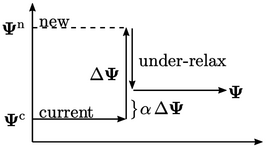5.6 Under-relaxation
Sec. 5.5 concludes that the matrix of a typical transport equation is not guaranteed to be diagonally dominant. Some action may therefore be required to ensure a convergent solution.
Under-relaxation is a general method used to improve solution convergence by limiting the amount a variable changes during a solution step.

During a solution step, assume a single value
of a field  in one cell changes from its current value
in one cell changes from its current value  to the new value
to the new value
 .
Under-relaxation would limit the change
.
Under-relaxation would limit the change  by a fraction
by a fraction
 ,
,
 ,
so that the value taken from that solution step is
,
so that the value taken from that solution step is
 |
(5.13) |
 in computer
memory.
in computer
memory.
When a solution step involves solving a matrix
equation, the new values  come from an iterative method like
Gauss-Seidel. Combining the under-relaxation of Eq. (5.13
) with the
Gauss-Seidel calculation of Eq. (5.4
) gives:
come from an iterative method like
Gauss-Seidel. Combining the under-relaxation of Eq. (5.13
) with the
Gauss-Seidel calculation of Eq. (5.4
) gives:
 |
(5.14) |
 |
(5.15) |
 modified by:
modified by:
- increasing the diagonal coefficients
 by division by
by division by
 ;
; - multiplying the difference between the new and
original
 coefficients by the current
coefficients by the current  and adding it to the
source
and adding it to the
source  .
.
Modifying the matrix equation this way, known as
equation
under-relaxation, provides an
alternative to Eq. (5.13
) for under-relaxing
a solution of  , without the temporary storage of
, without the temporary storage of  .
.
Ensuring diagonal dominance
The modification to  expressed by
Eq. (5.15
) inspires a
strategy to ensure diagonal dominance of the matrix as follows.
expressed by
Eq. (5.15
) inspires a
strategy to ensure diagonal dominance of the matrix as follows.
Each diagonal coefficient which does not satisfy
Eq. (5.9
) is increased until it
is diagonally equal. The change to the coefficient is multiplied by
the current  and added to
and added to  .
.
This approach to ensure diagonal dominance is
effective since it only modifies matrix coefficients where necessary.
Otherwise, if the discretisation schemes, and  and
and  are favourable,
then no changes to the matrix are necessary.
are favourable,
then no changes to the matrix are necessary.

